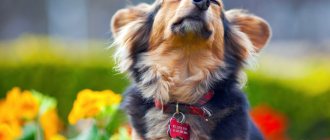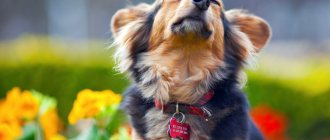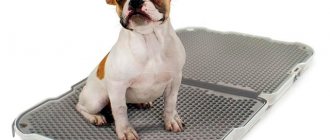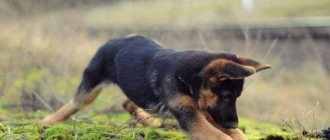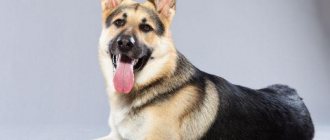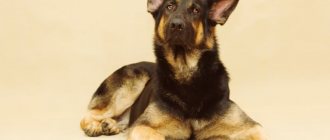Is it good to keep a dog on a chain?
Many owners who have just acquired a German Shepherd are wondering whether keeping the dog on a chain in a private home is good for them or is it better not to do it. It is impossible to answer this question unambiguously. It all depends on the dog itself and the place where it will live.
Let’s say that if the pet is docile, balanced and well-mannered, the chain will definitely not suit him. After all, such animals love freedom and space. Keeping him on a chain will only depress the psychological and emotional state of the shepherd. Such a pet can live peacefully in a booth, fenced with an enclosure or without one at all.
However, there are dogs whose character has pronounced aggression. The dog obeys only one human leader.
If strangers suddenly come to visit and the animal is not attached, it may end badly. Therefore, it is better to keep angry shepherd dogs on a chain or in a closed enclosure.
Previous Contents
If the puppy was kept in an enclosure with its mother, and by winter it became necessary to decide on a place to keep it, leave it in the same place. Living in the air, the puppy will get stronger, but walks are not canceled. The territory of a spacious enclosure is not enough to splash out the energy of a growing dog. It is allowed to let the dog out for a walk around the yard and close it when guests arrive. Otherwise, it is preferable to leave the puppy at home until three months of age, when a thick coat has formed and a warm undercoat has grown by winter, allowing it to withstand temperatures down to 20 degrees below zero. If the climate is too cold, the dog must be kept at home, otherwise the pet will freeze and get sick.
The main difficulty lies in the weather conditions that occur during the cold part of the year. The undercoat is important, but in cold and damp conditions the dog can get sick.
You cannot chain your puppy. Leash training is required from the first walks; tying is not allowed. For outdoor maintenance, an enclosure is installed. The breed is a freedom-loving breed; when chained, it will either get angry or become sad.
Dog booth
If a person wants a shepherd to live in a kennel, you can buy one at a pet store or make one yourself. The second option will be more comfortable for the animal, because in a kennel made to the dog’s individual size, it is not cramped and warm.
Before building a booth, it is important to choose a good place to install it. The kennel should be positioned so that the bitch or dog can freely see the entire area and those who came. In addition, it is necessary that the soil under the booth is dry. You cannot place a dog house on bare ground; you must install a foundation or underlay underneath it. The optimal distance from the house to the booth is 15 meters. It is unacceptable for the kennel to stand in a barn or near other animals. It is important to remember that the length of the booth must be such that the animal in it can lie down freely and stretch out its paws.
Only straw should be used as bedding, but in no case cloth rags or hay. After all, they absorb moisture and swell.
Keeping the booth clean
In addition to the above maintenance and care requirements, it is necessary to ensure cleanliness in the booth. A good tip is that when installing a booth with your own hands, you need to make an opening type roof. This way, the owner can always change the bedding, wash the inside of the booth, or disinfect it against fleas. After all, cleaning the kennel must be done regularly and thoroughly.
Material for construction
To build a reliable enclosure with a booth for a German Shepherd, you will need the following materials:
- cement;
- boards and planks made of coniferous trees;
- metal gratings and pipes;
- tiles, ondulin or slate;
- self-tapping screws
The floor is made from boards, raising them above the ground and laying them on a slight slope to make it easier to wash off dirt. They are pre-treated with impregnation against rotting. It is not advisable to pour a cement floor - a dog lying on concrete can become hypothermic and get sick. Corrugated sheeting is not recommended for use on roofs, since it heats up in summer, cools down in winter, and creates a lot of noise when it rains.
Wood or brick is used to install three walls, and a welded or forged lattice is used for the fourth. A chain-link mesh is not suitable, as the German will jump on it and may break the wire and injure his paws.
Aviary for a German
If the owner decides that the shepherd will live in an enclosure, he must carefully monitor the pet’s health. A bitch or a dog, especially if they are still puppies, should not stay in the enclosure all day long. This has a bad effect on the psyche of animals.
The enclosure should be spacious and have a house inside where the dog can hide during cold weather.
Cleaning the enclosure
The enclosure, like the booth, needs regular cleaning. After all, this is the place where the pet spends most of its time. It is important to clean the enclosure of waste products every day and disinfect it. In addition, it will be necessary to clean the fur, because a breed such as the German Shepherd sheds heavily.
How to properly maintain an apartment
Raising a large dog in a small apartment is not recommended. When settling a shepherd dog in a large room, you need to follow a number of certain rules:
- The German Shepherd needs a separate place to sleep and get proper rest. It should be located away from the passage, draft and heating source. You should not place your pet on a balcony, loggia or in the bathroom.
- It is worth purchasing special bedding with a sufficiently high density. The material must be easy to clean. A mat with a rubberized and non-slip bottom part is welcome.
- The problem is caused only by the animal's fur, which scatters around the room during active molting.
You should remove hair and clean the apartment as often as possible, especially if there are small children or elderly people among the residents. To reduce the frequency of cleaning, it is recommended to regularly comb your pet using a furminator.
In a large apartment you can keep a shepherd dog and walk it often
Shepherd care
When a shepherd dog constantly lives on the street, it is more susceptible to external factors that negatively affect its health. To protect your pet from their influence, it is recommended to take good care of your dog. Here are some tips for caring for your German Shepherd:
- It is necessary to check the condition of the animal's paws every day. After all, if even a small thorn or splinter gets under the skin, it can cause an inflammatory process and purulent formations.
- In the period from May to September, you need to choose a product to protect your shepherd from blood-sucking insects. These can be various sprays, tablets and special collars.
- It is important to clean your pet's ears 2 times a week to avoid infection. This can be done with a cotton swab dipped in a chlorhexidine solution.
- You also need to give your dog special products to remove tartar and plaque. Pet stores sell special cleaning bones that the dog will chew and thereby cleanse its mouth. They also sell toothpastes and brushes for dogs.
- Since this breed sheds heavily, it is important to brush your pet's coat every day with a special brush.
- It is better to bathe the animal once every 3 months.
- Nails should be trimmed once a week unless your pet has worn them off on a hard surface.
It is worth adding that when choosing care products, they should be selected taking into account the allergic reactions of the shepherd dog. It is better to buy hypoallergenic shampoos intended strictly for dogs. Also read our article on feeding a German Shepherd
Growth from 1 to 12 months
The table below shows how approximately the parameters of German Shepherd puppies should change during the first year by month:
| Age | Height at withers | Male weight | Bitch weight | Chest circumference |
| 1 month | 19-21 cm | 3.5-4 kg | 3-3.3 kg | 28-31 cm |
| 2 months | 32-38 cm | 8.5-9 kg | 7.5-8 kg | 46-49 cm |
| 3 months | 40-48 cm | 14-14.2 kg | 12-12.3 kg | 56-59 cm |
| 4 months | 47-56 cm | 19-20 kg | 16-16.4 kg | 60-64 cm |
| 5 months | 51-58 cm | 22-22.9 kg | 20-21.7 kg | 65-70 cm |
| 6 months | 52-60 cm | 24-26 kg | 22.5-23 kg | 68-72 cm |
| 7 months | 53-61 cm | 28-28.4 kg | 23-24.7 kg | 70-72 cm |
| 8 months | 53-61 cm | 29-30 kg | 25-25.2 kg | 72-74 cm |
| 9 months | 53-61 cm | 30.5-32 kg | 27-27.5 kg | 74-75 cm |
| 10 months | 54-62 cm | 32.3-32.9 kg | 28-29 kg | 75-76 cm |
| 11 months | 54-62 cm | 33-33.5 kg | 28-29 kg | 75-76 cm |
| 12 months | 55-63 cm | 33-34 kg | 30-32 kg | 75-76 cm |
It is important to understand that the data given in the table are averaged, and the growth and development of the pet may not coincide with them, because
First of all, it depends on factors such as:
- individual characteristics of the body;
- feeding and so on.
However, if the deviations are too great and there are doubts about the sequence of development of the puppy, you should consult a veterinarian.
The height of an adult German Shepherd should be approximately equal to the length of its body, excluding the tail, which is why the dog looks almost “square”, and the chest circumference should be 5-7 cm greater than the length of the body.
The active growth phase of German Shepherds ends when they reach one year of age. But the dog’s development does not stop there, and the pet is fully formed only by 2 years. At this time, muscle mass increases, chest volume increases, and bone formation occurs.
Walking and working with the dog
The German Shepherd is a very intelligent, reasonable and understanding creature. Dog handlers have found that she is capable of achieving such mental development that can be compared with the mind of a five-year-old child. Such a dog cannot live without communication with a person.
Most often, the animal chooses one owner in the family, to whom it becomes attached with all its soul. He is able to develop this intelligence in the dog and teach him good upbringing.
What a German Shepherd puppy will turn into depends only on the owner. Therefore, it is important to work with the dog, train and reward it for its achievements.
As for walks, they should be constant and regular. If the animal is still small, it needs to be taken outside the country house and yard, shown the world and nature, and played various games with it. It is important that the puppy gets used to other animals, strangers and noise. Otherwise, he will grow into a frightened animal.
For an adult dog, fast paced walks and various exercises are suitable. This will allow the dog to throw out negative energy and improve its physical qualities.
What to feed a puppy at the age of 1 month
Most often, puppies are sold at the age of 45 days, when certification has been completed. At this point, the puppy’s diet includes:
- two types of meat;
- rice and oatmeal;
- milk;
- cottage cheese and kefir.
The baby's stomach is still small and his metabolism is fast. Therefore, babies need to be given a small portion of food every 3 hours. From 1 to 2 months, the fastest growth is observed: a two-month-old puppy is 2 times larger than a month-old one. This means that the nutritional value and digestibility of the feed must be high.
By receiving raw meat several times a day, the baby will grow before our eyes. Dogs are carnivores. In the wild, adults feed their babies raw meat. Therefore, if finances allow, the content of this product in the diet should be maximum.
You can also give boiled meat, it is nutritious, strengthens the stool well, so it is useful for minor digestive disorders. Most often, the meat is boiled, porridge is prepared in broth, then the chopped meat is mixed with warm porridge, diluted a little with water if it is too thick, and given to the puppy.
Meat porridge should not be diluted with milk, since casein, which is formed in the stomach during the digestion of milk, slows down the absorption of nutrients.
Milk porridges are made from Hercules or rice, since semolina is difficult to digest.
Cottage cheese can be diluted with kefir or a raw chicken egg can be added, since viscous or too dry cottage cheese can cause puppies to choke. Many kids do not like this healthy product, then you can try making cottage cheese yourself from a pack of kefir or pouring fermented baked milk mixed with a raw egg into boiling milk. Homemade cottage cheese is more tender, aromatic and tasty.
Why is it important to take the Protective Guard Course and the General Pet Training Course?
If the owner wants to make a real guard out of the dog, it will not hurt the shepherd to take a course in protective guard duty. This can have a good effect not only on the animal, but also on the owner. After all, constant barking gets on the nerves of the inhabitants of the house and neighbors. In addition, this does not have a very good effect on the pet itself. The dog must know where is a stranger who poses a danger, and where is just a passer-by who does not wish harm.
During protective guard service courses, the animal is taught to correctly recognize the enemy, and also to bite in places that will not cause much harm (hands).
The shepherd dog also needs to undergo a general training course. Of course, the owner can work with the dog himself. But experienced dog handlers will do it faster and much better.
In conclusion, we would like to add that keeping a German Shepherd is a great responsibility for the life of the animal. If everything is done correctly, the animal will become a good companion and will last up to 10 years. The main thing is that she feels love and care. Then the pet will always thank the owner with his devotion and loyalty.
Feeding a German Shepherd puppy at 2-3 months of age
By this age, the baby has already grown noticeably and become a little stronger. The same applies to the organs of the digestive tract. The stomach is able to digest fiber of plant origin. This means that now is the time to introduce boiled carrots into your diet. You need to add one teaspoon of sunflower oil (unrefined) to the porridge.
The volume of food must be increased to 300 grams. per day, feeding frequency – 5 times. The puppy also needs additional mineral supplements in the form of vegetables and fruits. Therefore, babies are offered an apple or a piece of watermelon between feedings. In winter, when there is not enough sunlight, the dog is given an additional drop of vitamin D diluted in oil, so it is better absorbed.
To develop jaws and scratch teeth, it is worth giving your pet a large brain bone. The little one will happily chew on it and play with it for a long time. If the puppy lives on the street, then it is better to give the bone raw, as it is healthier. In an apartment, in order to avoid an unpleasant odor from the “toy”, it is lightly welded. And then soups and porridges are prepared for the dog using this broth.

